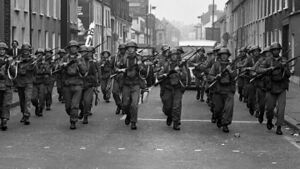The Pahlan Insurgencies
| The Pahlan Insurgencies | |||||
|---|---|---|---|---|---|
 Zamastanian Armed Forces soldiers marching to a protest site in Emerald in 1957. | |||||
| |||||
| Belligerents | |||||
|
| |||||
| Commanders and leaders | |||||
|
|
Orville Samu Franklin Dapez | ||||
| Casualties and losses | |||||
|
Zamastan
|
Free Pahlan Front
| ||||
|
Civilians killed: 2,840 Total dead: 6,532 Total injured: 77,500+ | |||||
The Pahlan Insurgencies were a series of ethno-nationalist clashes in the province of Pahl in Zamastan during the mid 20th century. Also known internationally as the Pahlan Independence Movement, it is sometimes described as an "irregular war" or "low-level war". The conflict began in the early 1950s during the height of the World War and is usually deemed to have ended with the Sherburne Agreement of 1958. Although the Pahlan Insurgencies primarily took place in Pahl, at times the violence spilled over into parts of the provinces of Zian, Northern Isle, and Jade. The conflict was primarily political and nationalistic, fueled by historical events. It also had an ethnic or sectarian dimension, although it was not a religious conflict. A key issue was the constitutional status of Pahl. Unionists/loyalists, who were mostly members of the Church of Zian, wanted Pahl to remain within the Republic of Zamastan. Pahlan nationalists/republicans, who were mostly members of the Catholic Church of Zamastan, wanted Pahl to leave the Republic. Depending on the faction, there were independence movements, as well as movements to join bordering Gladysynthia to the north and some who, during the World War, wanted to join Drambenburg.
Increasing tensions led to severe violence in August 1955 and the deployment of Zamastanian troops, and there was near consistent occupation of major Pahlan urban areas such as Abagene, Alanis, and Emerald, and many small villages until the Sherburne Agreement of 1958 ended the fighting. The main participants in the Insurgencies were republican paramilitaries such as the Free Pahlan Front (FPF) and the Pahlan National Liberation Army (PNLA); loyalist paramilitaries such as the Emerald Volunteer Force (EVF) and Alanis Defence Association (ADA); Zamastanian federal security forces—the Zamastanian Armed Forces; and political activists and politicians. Paramilitaries carried out a guerrilla campaign against the Zamastanian security forces, as well as a bombing campaign against infrastructure, commercial and political targets. Zamastanian security forces undertook both a policing and a counter-insurgency role, primarily against the rebel groups. The Insurgencies also involved numerous riots, mass protests and acts of civil disobedience, and led to segregation and the creation of no-go areas.
More than 6,532 people were killed in the conflict, of whom 40% were civilians. There were sporadic outbreaks violence after the Sherburne Agreement was signed, including a campaign by anti-ceasefire rebels, until the mid 1960s. Though the movement widely died down and practically went away entirely by the 1970s, it is believed that the insurgencies invigorated independence campaigns in Mayotte and Auraine, and the creation of the Bloc Mayotte party was a direct result of the political chaos after the insurgencies. As a result of the lasting legacy of the insurgencies, the Bettencourt movement of 2019-20 eventually culminated in the independence of the Three Eastern Provinces.
Background
1953-54
August 1955
Deployment of Federal Forces
Federal Occupation of Pahl
First Ceasefire
1956-57
1958
Second Ceasefire
Third Ceasefire
Sherburne Agreement
Aftermath
Casualties
Social repercussions
International Reactions
Verdusa
Hardline catholics of Verdusa were open in their support of the Free Pahlan Front's independence movement. The Verdusan government was quietly sympathetic to the separatist cause. However, there were multiple cases of individual Verdusans, both living in Verdusa and abroad in Zamastan, travelling to fight for the separatists in Pahl. There were concerns from Zamastanian authorities that Verdusian government officials were covertly funding separatist movements, though this was merely speculation.
